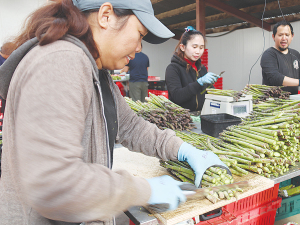Spinach tops leafy green sales in New Zealand
Spinach is NZ's favourite leafy green, according to the Department of Statistics.
 Leaderbrand manager Mike Arnold says the 25% of the country’s asparagus that is grown in the South Island is pretty special.
Leaderbrand manager Mike Arnold says the 25% of the country’s asparagus that is grown in the South Island is pretty special.
The first of the last asparagus to be grown in NZ will be coming on the market soon.
The cool nights and warm days of the Canterbury plains, near the township of Chertsey, is the site of a large asparagus growing operation by one of the country's largest vegetable growers - Leaderbrand.
The company, whose head office is in Gisborne, has been growing asparagus in the South Island for more than 10 years. Most of the asparagus we see in supermarkets is grown in the North Island, but the 25% grown in the South Island is pretty special, according to Leaderbrand manager Mike Arnold.
He says the idea of growing the tasty seasonal vegetables came when a local asparagus breeder - with the help of plant scientists - developed a variety that suited the local climate. Arnold says the deep sandy soils provide a perfect conduit for the plants - combined with less rainfall and long, hot, dry summers - making for perfect growing conditions.
"This adds to the flavour of the spears. Cool nights and snow, which is on the mountains right now, brings out the flavour and increases the brix or sugar levels," he told Hort News. "So, a nice, sweet-tasting flavour is what we have here. While there is no absolute proof, in my opinion, the alpine asparagus we produce is the pick of the bunch."
The first asparagus on the market is from the North Island and it comes on the market in September, while those in South Island are harvested in October and through to Christmas. This means that Leaderbrand has product available for four months. While most of the asparagus grown in the South Island is sold there, it also provides product for the North Island as the season extends into December.
Growing asparagus is akin to establishing an apple or kiwifruit orchard, Arnold explains. He points out it takes three years to get the first small crop, but if the crop is carefully maintained - and not picked too hard at any time - it can produce for between 15 and 20 years.
Arnold says the key things they look for in a crop is the colour, flavour, disease resistance and the field holding capacity of the plants.
Harvesting the crop is different to most others as the green spears appear almost overnight - sometimes growing 17cm in a day. Leaderbrand employ 35 RSE workers from Vanuatu to pick the crop and about another 30 locals to manage this and the packhouse operation.
Overall, there are about 10 permanent staff at the site, which also produces courgettes as well as processed peas, barley and seed crops. The latter are used as rotational crops.
Arnold has been involved in the asparagus growing operation for the past 10 years and is proud of the crop they produce.
He says asparagus is an extremely versatile vegetable, goes with any meal and is easy to prepare.
Craighead Diocesan, Darfield High School and Christchurch Boys' High School took out the three age groups at the Canterbury Clash of the Colleges, which was held at the recent Ashburton A&P Show.
The New Zealand Merino Company (NZM) is expanding its collaboration with TextileGenesis to deliver full traceability for 100% of ZQ certified wool and ZQRX regenerative wool.
According to Federated Farmers, Environment Southland has mishandled the consent process for Waituna Lagoon, leaving the community with numerous bad outcomes.
Metallica's charitable foundation, All Within My Hands (AWMH), teamed up with Meet the Need this week for a food packing event held at the New Zealand Food Network warehouse in Auckland.
After two years, Alliance Group has returned to profit.
According to Zespri's November forecast for the 2025/26 season, returns are likely to be up for all fruit groups compared to the last forecast in August.